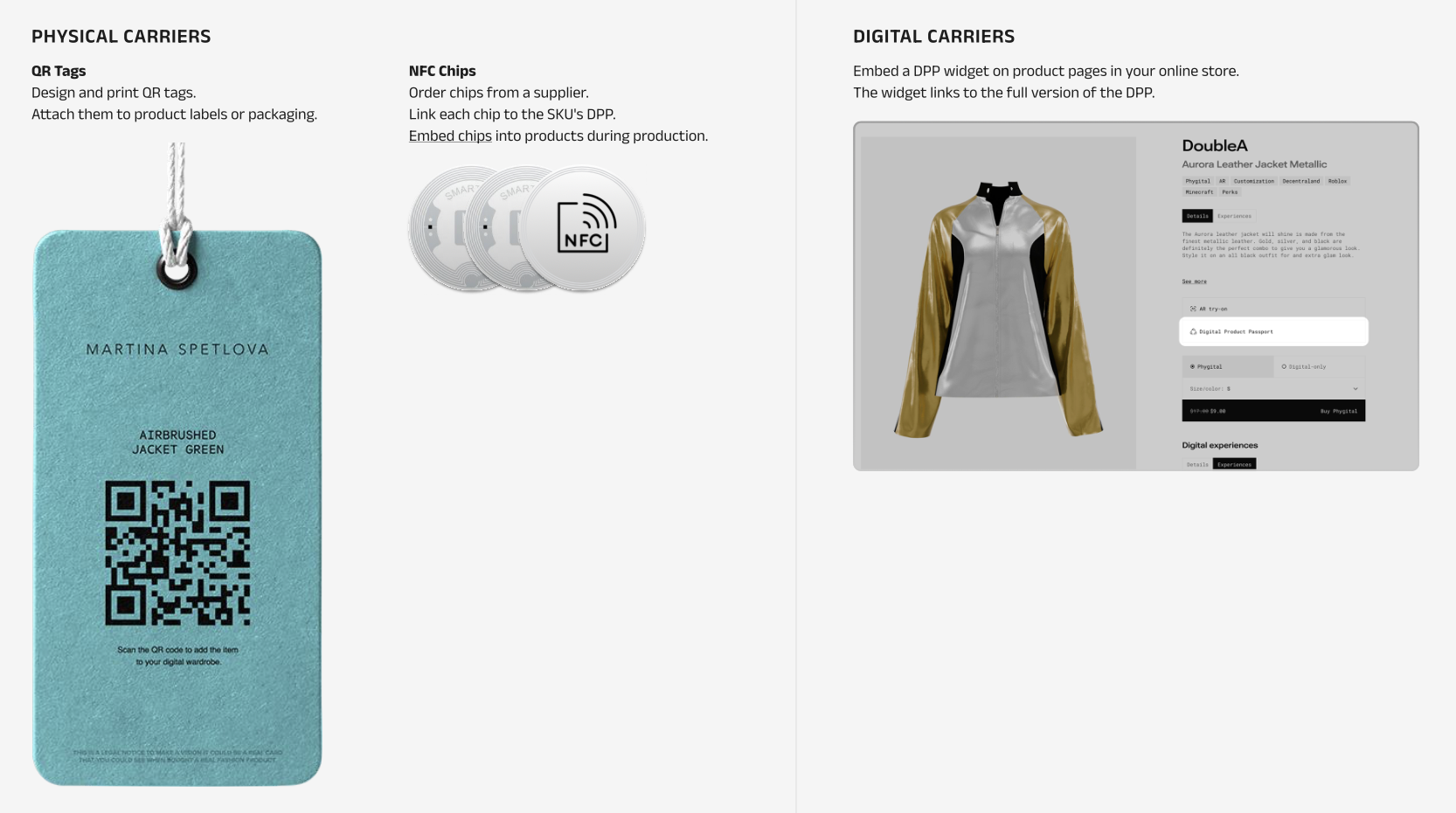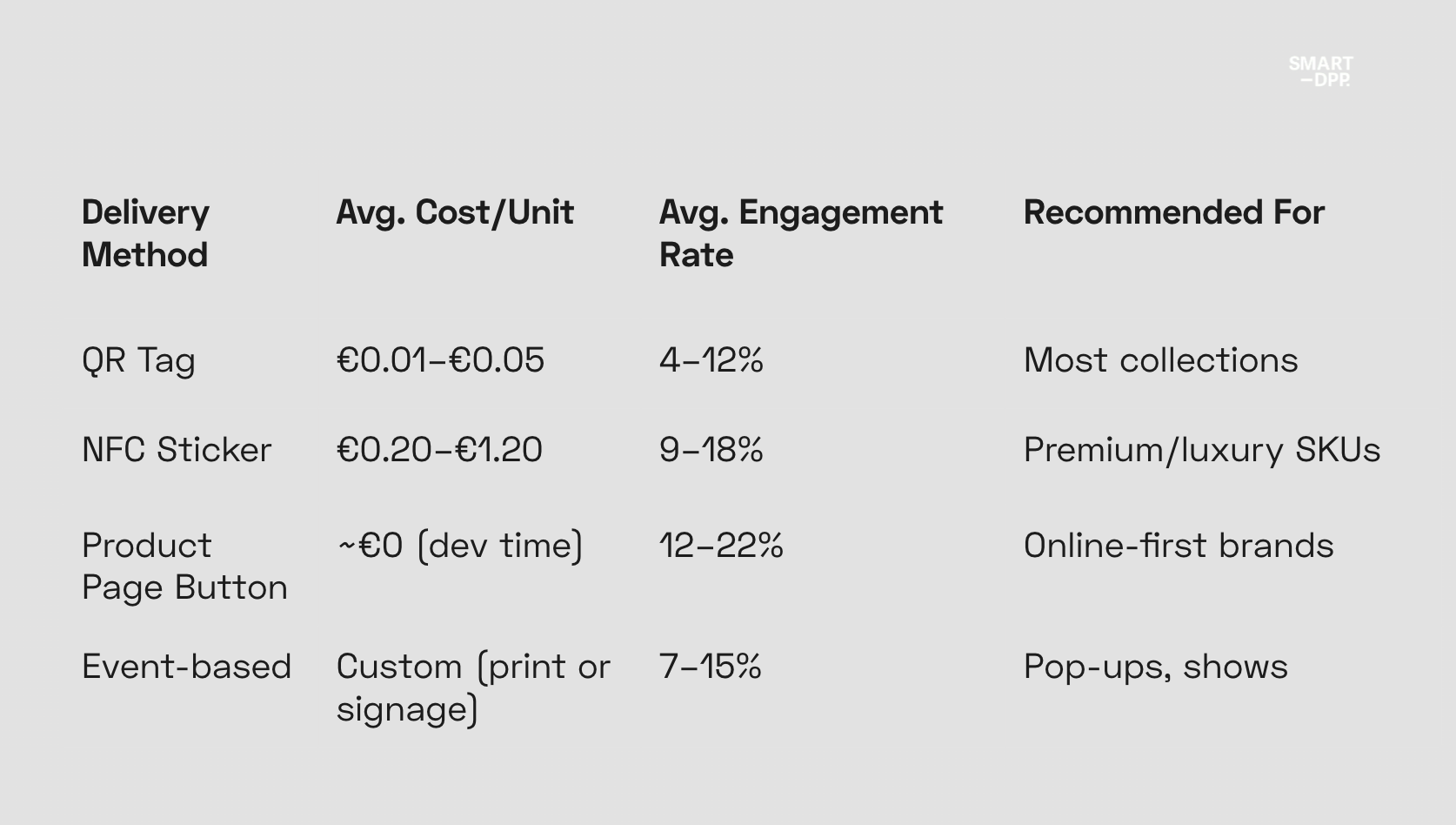If you're rolling out Digital Product Passports (DPPs), there’s one decision that will shape how your customers (and internal teams) actually experience them: how they’re delivered.
We’ve helped fashion brands—from heritage houses to launch-stage labels—test and scale different DPP delivery methods. And the takeaway is clear: the most successful DPPs meet people where they already are.
In this guide, we’ll break down the 4 most popular delivery methods, when to use them, what they cost, and how they perform. We’ll also share internal benchmarks to help you decide what works best for your products, retail strategy, and customer experience goals.
Let’s dive in.
1. QR Tags
The standard workhorse
QR codes printed on swing tags, care labels, or packaging are by far the most widely adopted method for delivering DPPs. They're cheap, versatile, and familiar to almost every customer.
Best for:
- Garments sold both online and in-store
- Limited-run collections or event pop-ups
- Mid-to-premium priced products
Pros:
- Easy to print and apply
- Low cost per unit (~€0.01–€0.05)
- Compatible with any smartphone camera
- Easy to combine with storytelling or visuals
Considerations:
- Vulnerable to wear and tear if printed on care labels
- Limited engagement if placed in hidden or hard-to-reach spots

2. NFC Stickers
The premium tap-and-go experience
Near Field Communication (NFC) stickers provide a tap-to-access experience and are ideal for brands looking to elevate interactivity, security, or uniqueness.
Best for:
- Premium and luxury garments
- Authentication and anti-counterfeiting
- Collectibles or digital twin-linked drops
Pros:
- Seamless user experience (no camera required)
- Can be embedded or concealed for clean aesthetics
- Can store dynamic or locked data
Considerations:
- Higher cost per unit (~€0.20–€1.20)
- Requires additional setup during production
- Not all phones (esp. older models) support NFC
3. Product Page Buttons
Where the traffic already is
Adding a “Digital Product Passport” button directly on your product pages (via Shopify, WooCommerce, or custom CMS) ensures visibility during online shopping—when intent is highest.
Best for:
- DTC brands with strong online presence
- Regulatory compliance visibility
- Products made-to-order or pre-sale
Pros:
- No physical logistics involved
- Easily updatable and testable
- Great for SEO and trust building
Considerations:
- Doesn’t support resale or secondhand tracking
- No access point for offline retail or post-purchase use
4. Event-Based Delivery
Physical meets digital
DPPs don’t have to live only on the product. Some brands link them to showroom displays, invitation cards, lookbooks, or fashion week presentations—making the product story part of the moment.
Best for:
- Fashion weeks and trade shows
- Press kits and buyer experiences
- Capsule collections and showroom-only items
Pros:
- Great for engagement and storytelling
- Allows for pre-launch interaction
- Drives traffic to product pages or brand content
Considerations:
- Less scalable than other methods
- Not ideal for long-term customer access
How the Methods Compare
Here’s what we’ve seen across our internal pilots and brand collaborations:

And from a recent cross-brand survey:
Adoption by Method (% of brands using)
- QR Tags – 82%
- Product Page Buttons – 63%
- NFC Stickers – 26%
- Event-Based Delivery – 18%
Our Take
There’s no single “best” method—but there is a best-fit for your context. Most brands do well with a hybrid approach:
- QRs for scale
- NFC for standout products
- Product page buttons for digital journeys
- Event-based touchpoints to generate buzz
Want help choosing? We’re happy to share recommendations based on your price point, production setup, and storytelling goals.
Let the passport fit the product.




